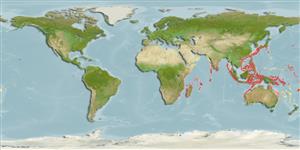Common names from other countries
Klassifizierung / Names
Namen | Synonyme | Catalog of Fishes(Gattung, Arten) | ITIS | CoL | WoRMS | Cloffa
Elasmobranchii (Haie und Rochen) (sharks and rays) >
Squaliformes (Sleeper and dogfish sharks) >
Centrophoridae (Gulper sharks)
Etymology: Centrophorus: centr[um] (L.), prickle or sharp point; phorus, from phoreus (Gr.), bearer or carrier, referring to grooved spines on dorsal fins. (See ETYFish); atromarginatus: atro-, from ater (L.), black; marginatus (L)., bordered, referring to black edging on all or most fins. (See ETYFish).
More on author: Garman.
Environment: milieu / climate zone / depth range / distribution range
Ökologie
seewasser bathydemersal; tiefenbereich 183 - 450 m (Ref. 31367). Deep-water
Indo-West Pacific: Gulf of Aden, Japan, Taiwan, and northern Papua New Guinea. Often confused with Centrophorus granulosus.
Size / Gewicht / Alter
Maturity: Lm ? range ? - ? cm
Max length : 87.0 cm TL Männchen/unbestimmt; (Ref. 31367)
Rückenflossenstacheln (insgesamt) : 2; Afterflossenstacheln: 0. Adults with tips of dorsal fins black, prominently marked from base of fins (Ref. 31367).
A little-known deepwater dogfish found on the upper continental slopes to at least 450 m (Ref. 31367). Ovoviviparous (Ref. 50449). Probably taken in bottom trawls (Ref. 31367). Caught by demersal longline fisheries operating in deepwater areas. Utilised for its meat, fins (low value) and liver oil (very high value) (Ref.58048).
Life cycle and mating behavior
Maturities | Fortpflanzung | Spawnings | Egg(s) | Fecundities | Larven
Ovoviviparous, embryos feed solely on yolk (Ref. 50449). Distinct pairing with embrace (Ref. 205). Gives birth to a single pup. Born at 28-36 cm TL (Ref.58048).
Compagno, L.J.V. and V.H. Niem, 1998. Squalidae. Dogfish sharks. p. 1213-1232. In K.E. Carpenter and V.H. Niem (eds.) FAO Identification Guide for Fishery Purposes. The Living Marine Resources of the Western Central Pacific. FAO, Rome. (Ref. 31367)
IUCN Rote Liste Status (Ref. 130435)
CITES (Ref. 128078)
Not Evaluated
Bedrohung für Menschen
Harmless
Nutzung durch Menschen
Tools
Zusatzinformationen
Download XML
Internet Quellen
Estimates based on models
Preferred temperature (Ref.
115969): 11.2 - 18.8, mean 14.2 (based on 105 cells).
Phylogenetic diversity index (Ref.
82804): PD
50 = 0.5001 [Uniqueness, from 0.5 = low to 2.0 = high].
Bayesian length-weight: a=0.00263 (0.00121 - 0.00572), b=3.18 (2.99 - 3.37), in cm Total Length, based on LWR estimates for this (Sub)family-body shape (Ref.
93245).
Trophic level (Ref.
69278): 4.3 ±0.3 se; based on size and trophs of closest relatives
Widerstandsfähigkeit (Ref.
120179): niedrig, Verdopplung der Population dauert 4,5 - 14 Jahre. (Fec assumed to be <100).
Fishing Vulnerability (Ref.
59153): Moderate to high vulnerability (55 of 100).
